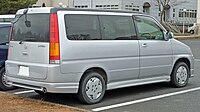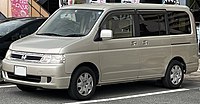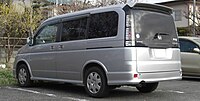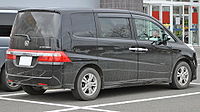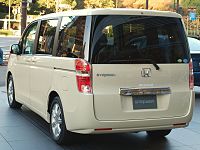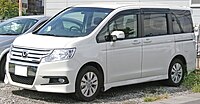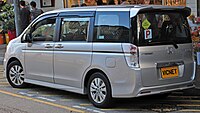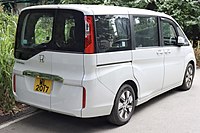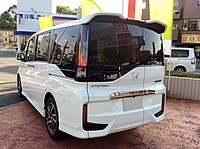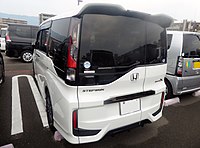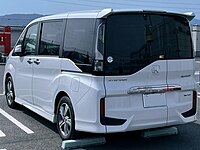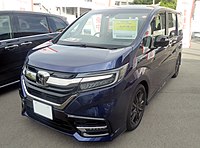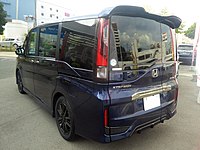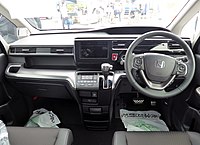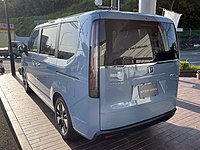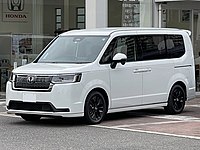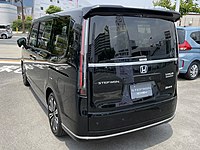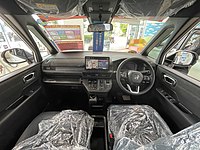Honda Stepwgn
| Honda Stepwgn | |
|---|---|
 2018 Honda Stepwgn Spada (RP3) | |
| Overview | |
| Manufacturer | Honda |
| Production | 1996–present |
| Assembly | Japan: Sayama, Saitama (Sayama Plant, 1996–2021); Yorii, Saitama (Yorii Plant, 2022–present) |
| Body and chassis | |
| Class | Minivan |
| Layout | Front-engine, front-wheel-drive Front-engine, four-wheel-drive |
The Honda Stepwgn (stylised as STEPWGN and pronounced "step wagon") is a minivan produced by Honda since 1996. In contrast to the Odyssey and also the Stream, it sports a taller, more upright greenhouse and can accommodate eight people instead of seven. For its first two generations, the car had one door on the driver's side and two doors on the passenger's side.
The Stepwgn competes against the Nissan Serena, Toyota Noah, Mitsubishi Delica, and formerly, the Mazda Biante.
First generation (RF1/2; 1996)
[edit]| First generation | |
|---|---|
 Honda Stepwgn (pre-facelift) | |
| Overview | |
| Model code | RF1/2 |
| Production | 1996–2001 |
| Body and chassis | |
| Body style | 4-door minivan |
| Powertrain | |
| Engine | 2.0 L (122.0 cu in) B20B 125 PS (91.9 kW) I4 |
| Transmission | 4-speed automatic |
| Dimensions | |
| Wheelbase | 2,855 mm (112 in) |
| Length | 4,705 mm (185 in) |
| Width | 1,695 mm (67 in) |
| Height | 1,815 mm (71 in) |
| Curb weight | 1,410–1,645 kg (3,109–3,627 lb) |

F-MX (1995)
[edit]The first generation Stepwgn originally appeared at the Tokyo Motor Show as the F-MX in 1995.
Initial release (1996)
[edit]Japanese sales began on 8 May 1996. At that time, most Japanese minivans usually had the engine mounted under the cabin. The Stepwgn used a more conventional two-box layout, and was based on the Civic to reduce costs (starting from ¥1,548,000 and going up to ¥2,368,000).[1] The passenger side was fitted with a sliding door for easier access. To improve profitability, further cost reduction measures were used, such as there being only one engine and transmission option—a two-litre inline-four and a 4-speed automatic transmission[2]—and the vehicle's design reduced the use of steel panels and parts.
1997 update
[edit]Changes for 1997 included standardizing ABS and dual SRS airbags throughout the range, as well as the addition of a number of convenience features. Japanese models went on sale in August 1997 at Honda's Primo, Verno and Clio networks.[3]
Stepwgn Almas (1997)
[edit]The Stepwgn Almas, whose name is derived from the Spanish alma ("heart"; "soul"), was equipped with a second-row seat lift for elderly and physically handicapped passengers.[4]
Stepwgn Field Deck (1998)
[edit]A version of the Stepwgn with a pop-up observation tent and fibre-reinforced plastic (FRP) body, designed for outdoor leisure pursuits, was sold at Japanese Honda dealers from January 1998.[5]
1999 update
[edit]The Stepwgn received a facelift in May 1999. The appearance of the headlights was altered and the rear license plate was moved down.
-
Honda Stepwgn (facelift)
-
Honda Stepwgn (facelift)
Second generation (RF3/4/5/6/7/8; 2001)
[edit]| Second generation | |
|---|---|
 Honda Stepwgn (pre-facelift) | |
| Overview | |
| Model code | RF3/4/5/6/7/8 |
| Production | 2001–2005 |
| Body and chassis | |
| Body style | 4-door minivan |
| Powertrain | |
| Engine | 2.0 L (122.0 cu in) K20A 160 PS (117.7 kW) I4 2.4 L (146.5 cu in) K24A 162 PS (119.2 kW) I4 [6] |
| Transmission | 4-speed automatic (2.0L) 5-speed automatic (2.4L) |
| Dimensions | |
| Wheelbase | 2,855 mm (112 in) |
| Length | 4,705 mm (185 in) |
| Width | 1,695 mm (67 in) |
| Height | 1,815 mm (71 in) |
| Curb weight | 1,490–1,620 kg (3,285–3,571 lb) |
Initial release
[edit]
The second-generation Stepwgn debuted in April 2001, largely based on the first generation. It used a design geared towards families with children. The Stepwgn retained the sliding door located on one side, and its seating allowed for four different seating arrangements: "play mode" (sitting opposite each other), "food mode", "sleep mode", and "cargo mode" (wherein the second row of seats is folded flat). A 2.0L Honda K20A i-VTEC engine provided the second-generation Stepwgn with 160 PS (117.7 kW; 157.8 hp), improving both driving performance and fuel economy. Some parts were stiffened in order to further enhance driving performance.
The vehicle was unveiled at the 35th Tokyo Motor Show.[7]
Stepwgn Almas (2001)
[edit]In addition to the second-row seat lift, the 2001 Stepwgn Almas included a seat lift option for the front-row passenger. Stepwgn Almas models went on sale on 11 June 2001.[8]
2003 update
[edit]In June 2003, Honda significantly modified the design: both the front and rear fascias were altered to fit the look of other Honda vehicles, and the "Spada" series was introduced, available with slightly modified fender styling and a 2.4L K24A i-VTEC engine producing 162 PS (119.2 kW; 159.8 hp).
The vehicle was unveiled at the 37th Tokyo Motor Show in 2003.[9][10]
For the first 6 months of 2004, sales of the Stepwgn in Japan reached 24,389 units.[11]
-
Honda Stepwgn (facelift)
-
Honda Stepwgn Spada (facelift)
-
Honda Stepwgn Spada (facelift)
Third generation (RG; 2005)
[edit]| Third generation | |
|---|---|
 2005–2007 Honda Stepwgn (pre-facelift) | |
| Overview | |
| Model code | RG |
| Production | 2005–2009 |
| Body and chassis | |
| Body style | 5-door minivan |
| Powertrain | |
| Engine | 2.0 L (122.0 cu in) K20A 155 PS (114.0 kW) I4[12] 2.4 L (146.5 cu in) 162 PS (119.2 kW) K24A I4[13] |
| Transmission | 4-speed automatic (2.0L) 5-speed automatic (2.4L 4WD) CVT (2.4L FWD) |
| Dimensions | |
| Wheelbase | 2,855 mm (112 in) |
| Length | 4,630 mm (182 in) |
| Width | 1,695 mm (67 in) |
| Height | 1,770 mm (70 in) |
| Curb weight | 1,540–1,660 kg (3,395–3,660 lb) |
Announced on 26 May 2005, the third-generation Stepwgn had a much more aerodynamic design than its predecessors.
Unlike the previous generations, which only featured sliding doors on one side, the third generation featured sliding doors on both sides, in order to compete with other minivans such as the Nissan Serena and Toyota Noah. Although the size of the car was decreased, interior space remained unchanged thanks to a new low-floor chassis, which also improved the handling of the vehicle. The overall length had been shortened, though the platform retained the Civic-based design and employed a thin plastic fuel tank in order to provide a low floor, which was covered in panelling meant to evoke wood flooring. Japanese models went on sale on 27 May 2005 at Honda dealers.[14]
The third-generation Stepwgn is powered by either a 2.0L K20A engine rated at 155 PS (114.0 kW), or a 2.4L K24A engine rated at 162 PS (119.2 kW). In the Stepwgn, they use a timing chain,[citation needed] as the engine is of an interference design. The 2.0L model retained a 4-speed automatic transmission, whilst the FWD 2.4L model was fitted with a CVT transmission.
At the month of November 2005, sales of Stepwgn in Japan reached 7,093 units.[15]
-
2005–2007 Honda Stepwgn (pre-facelift)
-
2007–2009 Honda Stepwgn (facelift)
-
2007–2009 Honda Stepwgn (facelift)
-
2007–2009 Honda Stepwgn Spada (facelift)
-
2007–2009 Honda Stepwgn Spada (facelift)
Tokyo Auto Salon concepts (2006)
[edit]The Modulo Stepwgn Concept and Stepwgn Modulo Concept X Final Room are concept cars based on the Stepwgn, with around-vehicle sensors. These vehicles were unveiled at the 2006 Tokyo Auto Salon.[16][17][18]
2006 update
[edit]For 2006, changes to the Stepwgn included:
- the addition of first- and second-row seat lift options to the G trim
- the inclusion of a power rear left sliding door as standard for the G, G S Package, and 24Z
- the inclusion of both power rear sliding doors as standard for the G L Package and G LS Package
- a new setting for the smart key system (with 2 keys)
- hydrophilic/heated side-view mirrors and hydrophobic front door glass
Japanese models went on sale in May 2006.[19]
Fourth generation (RK; 2009)
[edit]| Fourth generation | |
|---|---|
 Honda Stepwgn (pre-facelift) | |
| Overview | |
| Model code | RK |
| Production | 2009–2015 |
| Body and chassis | |
| Body style | 5-door minivan |
| Powertrain | |
| Engine | 2.0 L (122 cu in) R20A 150 PS (110.3 kW) I4[20] |
| Transmission | 5-speed automatic CVT |
| Dimensions | |
| Wheelbase | 2,855 mm (112 in) |
| Length | 4,690 mm (185 in) |
| Width | 1,695 mm (67 in) |
| Height | 1,815 mm (71 in) |
| Curb weight | 1,580–1,750 kg (3,483–3,858 lb) |
The fourth generation Stepwgn was a full redesign of the model, increasing in height and length but remaining the same width. The Stepwgn Spada model returned with a unique grille and headlamp design. The fourth-generation Stepwgn was available in seven trim levels: G, G L Package, L, Li, Spada S, Spada Z and Spada Zi. The 2.4-litre engine was dropped from the lineup, with only a 2.0-litre option available. The Stepwgn was available with either front- or four-wheel-drive across the range.[21]
Japanese models went on sale in October 2009.[22]
For the month of July 2013, sales of the Stepwgn reached 6,715 units.[23]
-
2009 Honda Stepwgn (pre-facelift)
-
Honda Stepwgn Spada (pre-facelift)
-
Honda Stepwgn Spada (pre-facelift)
-
Interior
Modulo Stepwgn (2010)
[edit]The Modulo Stepwgn is a production vehicle based on the standard Stepwgn. The vehicle was unveiled at the 2010 Tokyo Auto Salon.[24]
2012 facelift
[edit]In 2012, there were minor changes to the Stepwgn, including a new front grille, front bumper, rear lights, and wheels. A parking camera was also included on all models.
-
Honda Stepwgn Spada (facelift)
-
Honda Stepwgn Spada (facelift)
Stepwgn Modulo Style (2013)
[edit]The Stepwgn Modulo Style is a concept vehicle based on the standard Stepwgn. The vehicle was unveiled at the 2013 Tokyo Auto Salon.[25]
Fifth generation (RP1–5; 2015)
[edit]| Fifth generation | |
|---|---|
 2015 Honda Stepwgn (RP3; pre-facelift) | |
| Overview | |
| Model code | RP1–5 |
| Production | 2015–2022 |
| Body and chassis | |
| Body style | 5-door minivan |
| Powertrain | |
| Engine | 1.5L L15BF turbocharger I4 1.5L Honda LFA R-series HEV I4 2.0 L LFA1/LFB1 PGM-FI DOHC i-VTEC I4 + 2 electric motors |
| Electric motor | 2x Permanent Magnet Motors |
| Power output | 110 kW (150 PS; 148 hp) () 158 kW (215 PS; 212 hp) (Hybrid / e:HEV) |
| Transmission | CVT |
| Hybrid drivetrain | Honda Sport Hybrid Intelligent Multi Mode Drive (i-MMD) |
| Dimensions | |
| Wheelbase | 2,890 mm (114 in) |
| Length | 4,690 mm (185 in) 4,760 mm (187 in) (Spada) |
| Width | 1,695 mm (67 in) |
| Height | 1,840–1,855 mm (72–73 in) |
| Curb weight | 1,630–1,770 kg (3,594–3,902 lb) |
The fifth generation Stepwgn was introduced in April 2015. With an all-new 1.5-litre direct injection VTEC Turbo engine, the fifth generation Stepwgn features a functional cabin space, as well as a novel two-way tailgate called the Waku Waku Gate, derived from the Japanese term wakuwaku (わくわく, "exciting"). The Waku Waku Gate either functions as a traditional upwards-opening tailgate, or a smaller door that opens to the side for easier third-row access and cargo loading.[26]
-
2015 Honda Stepwgn (RP3; pre-facelift)
-
Honda Stepwgn Spada Cool Spirit (RP3; pre-facelift)
-
Honda Stepwgn Spada Cool Spirit (RP3; pre-facelift)
-
Honda Stepwgn Modulo X (RP3; pre-facelift)
-
Honda Stepwgn Modulo X (RP3; pre-facelift)
2017 facelift
[edit]The Stepwgn was refreshed[27] in September 2017. The Stepwgn Spada Hybrid has a 3-mode powertrain which can switch between EV, hybrid, or engine drive modes. It also has a Sport drive mode.[28]
It is equipped with a Honda Sensing system, which assists the driver with parking by controlling steering.[29]
-
Honda Stepwgn e:HEV Spada G EX Honda Sensing (RP5; facelift)
-
Honda Stepwgn e:HEV Spada G EX Honda Sensing (RP5; facelift)
-
Honda Stepwgn Modulo X Honda Sensing (RP3; facelift)
-
Honda Stepwgn Modulo X Honda Sensing (RP3; facelift)
-
Interior
Sixth generation (RP6–8; 2022)
[edit]| Sixth generation | |
|---|---|
 2022 Honda Stepwgn Air | |
| Overview | |
| Model code | RP6–8 |
| Production | 2022–present |
| Body and chassis | |
| Body style | 5-door minivan |
| Powertrain | |
| Engine | |
| Transmission | CVT |
| Dimensions | |
| Wheelbase | 2,890 mm (114 in) |
| Length | 4,800–4,830 mm (189–190 in) |
| Width | 1,750 mm (69 in) |
| Height | 1,840–1,855 mm (72–73 in) |
| Curb weight | 1,710–1,860 kg (3,770–4,101 lb) |
The sixth-generation Stepwgn was unveiled on 7 January 2022.[30][31] It is available in three models: Air, Spada, and Spada Premium Line. For this generation, the Waku Waku Gate was dropped in favour of a conventional automatic tailgate.[32] There is also a Stepwgn Air sports mix with a rear spoiler added. Other accessories include different rims and trim changes. The Spada comes with the Emotional Solid with different rims and trim.[clarification needed] In the promotion campaign, Honda reused the song Ob-La-Di, Ob-La-Da from the first gen StepWGN advertising, although this time Honda used a cover recorded by Superorganism, rather than the Beatles' original.
-
Stepwgn Air e:HEV rear view
-
Stepwgn e:HEV Spada
-
Stepwgn e:HEV Spada Premium Line rear view
-
Interior
Sales
[edit]| Year | Japan[33] |
|---|---|
| 1997 | 109,893 |
| 1998 | 93,280 |
| 1999 | 90,495 |
| 2000 | 79,270 |
| 2001 | 110,014 |
| 2002 | 71,128 |
| 2003 | 63,182 |
| 2004 | 46,700 |
| 2005 | 91,745 |
| 2006 | 78,216 |
| 2007 | 55,800 |
| 2008 | 44,441 |
| 2010 | 80,934 |
| 2009 | 43,020 |
| 2010 | 80,934 |
| 2011 | 48,797 |
| 2012 | 63,707 |
| 2013 | 62,206 |
| 2014 | 42,743 |
| 2015 | 53,699 |
| 2016 | 52,472 |
| 2017 | 46,457 |
| 2018 | 56,872 |
| 2019 | 52,676 |
| 2020 | 34,441 |
| 2021 | 39,247 |
| 2022 | 37,966 |
| 2023 | 44,157 |
References
[edit]- ^ "HONDA STEPWAGON catalog - reviews, pics, specs and prices | Goo-net Exchange". Archived from the original on 2013-01-24. Retrieved 2012-12-28.
- ^ "Detailed specs review of 1997 Honda Stepwgn Whitey offered since mid-year 1997 for Japan". www.automobile-catalog.com.
- ^ "Honda's StepWGN (Step Wagon) Goes Through a Minor Model Change".
- ^ "Honda Adds New "Almas" Version to StepWGN (Step Wagon) Line-Up". Honda Global. 1997-08-25. Retrieved 2023-06-30.
- ^ "Honda Launches Step WGN Field Deck with Pop-Up Roof".
- ^ "Detailed specs review of 2003 Honda Stepwgn Spada 24T offered since mid-year 2003 for Japan". www.automobile-catalog.com.
- ^ "Honda Automobile / Motorcycle Booth at the 35th Tokyo Motor Show".
- ^ "Honda Announces Full Model Changes for "STEP WGN" and "STEP WGN ALMAS"". Honda Global. 2001-04-05. Retrieved 2023-06-30.
- ^ "37th Tokyo Motor Show 2003 - Production Vehicles".
- ^ "Honda Announces Automobiles and Motorcycles to be Displayed at the 37th Tokyo Motor Show".
- ^ "Honda Achieves Record Global Auto Production for First Six Months of 2004".
- ^ "Detailed specs review of 2005 Honda Stepwgn B offered since mid-year 2005 for Japan". www.automobile-catalog.com.
- ^ "Detailed specs review of 2005 Honda Stepwgn 24Z offered since mid-year 2005 for Japan". www.automobile-catalog.com.
- ^ "Honda Introduces All-New Step Wagon". Honda Global. 2005-05-26. Retrieved 2023-06-30.
- ^ Honda Increases Production in North America due to Strong Sales
- ^ "【東京オートサロン06】写真蔵…ホンダ ステップワゴン コンセプト". レスポンス(Response.jp). 5 January 2006.
- ^ "【東京オートサロン06】ケータイ世代へ…ステップワゴン×ファイナル ホーム". レスポンス(Response.jp). 27 January 2006.
- ^ "【東京オートサロン06】ホンダブースにアシモが…". レスポンス(Response.jp). 13 January 2006.
- ^ "ホンダ ステップワゴン をマイナーチェンジで装備充実". レスポンス(Response.jp) (in Japanese). 18 May 2006.
- ^ "Detailed specs review of 2009 Honda Stepwgn G offered since October 2009 for Japan". www.automobile-catalog.com.
- ^ "Honda StepWGN available in Japan". Taume News. 2009-10-10. Archived from the original on 2009-10-12. Retrieved 2009-10-10.
- ^ Honda Announces the All-new Step WGN
- ^ Honda Sets All-Time Monthly Production Record for Automobile Production in Asia
- ^ Honda to show Insight Sports Modulo Concept, more at Tokyo Auto Salon
- ^ Overview of Honda Exhibit at TOKYO AUTO SALON 2013 with NAPAC
- ^ Mihalascu, Dan (April 23, 2015). "All-New Step WGN MPV Debuts Honda's New 148HP 1.5L VTEC Turbo Engine". Carscoops.
- ^ "Honda ステップ ワゴン 公式情報ページ". Honda公式ホームページ (in Japanese). Retrieved 2018-09-30.
- ^ "Honda ステップ ワゴン 公式情報ページ". Honda公式ホームページ.
- ^ "Honda ステップ ワゴン 公式情報ページ". Honda公式ホームページ (in Japanese). Retrieved 2018-09-30.
- ^ "新型「STEP WGN(ステップ ワゴン)」を初公開". 2023.
- ^ "Say Hello to the 2022 Honda Step WGN and All Its Boxy Goodness".
- ^ Lee, Jonathan (2022-01-10). "2022 Honda Step WGN MPV revealed – no more Waku Waku Gate; petrol and e:HEV variants to be offered". paultan.org. Malaysia. Retrieved 2022-11-30.
- ^ "ホンダ ステップワゴン 新車販売台数推移/売れ行き(生産台数)と生産状況は?生産工場も - 株式会社アイディーインフォメーション" [Honda Step Wagon new car sales trends/sales (production volume) and production status? production factory too]. id-information.co.jp (in Japanese). Retrieved 2024-04-20.
External links
[edit]- Official website (Japan)

